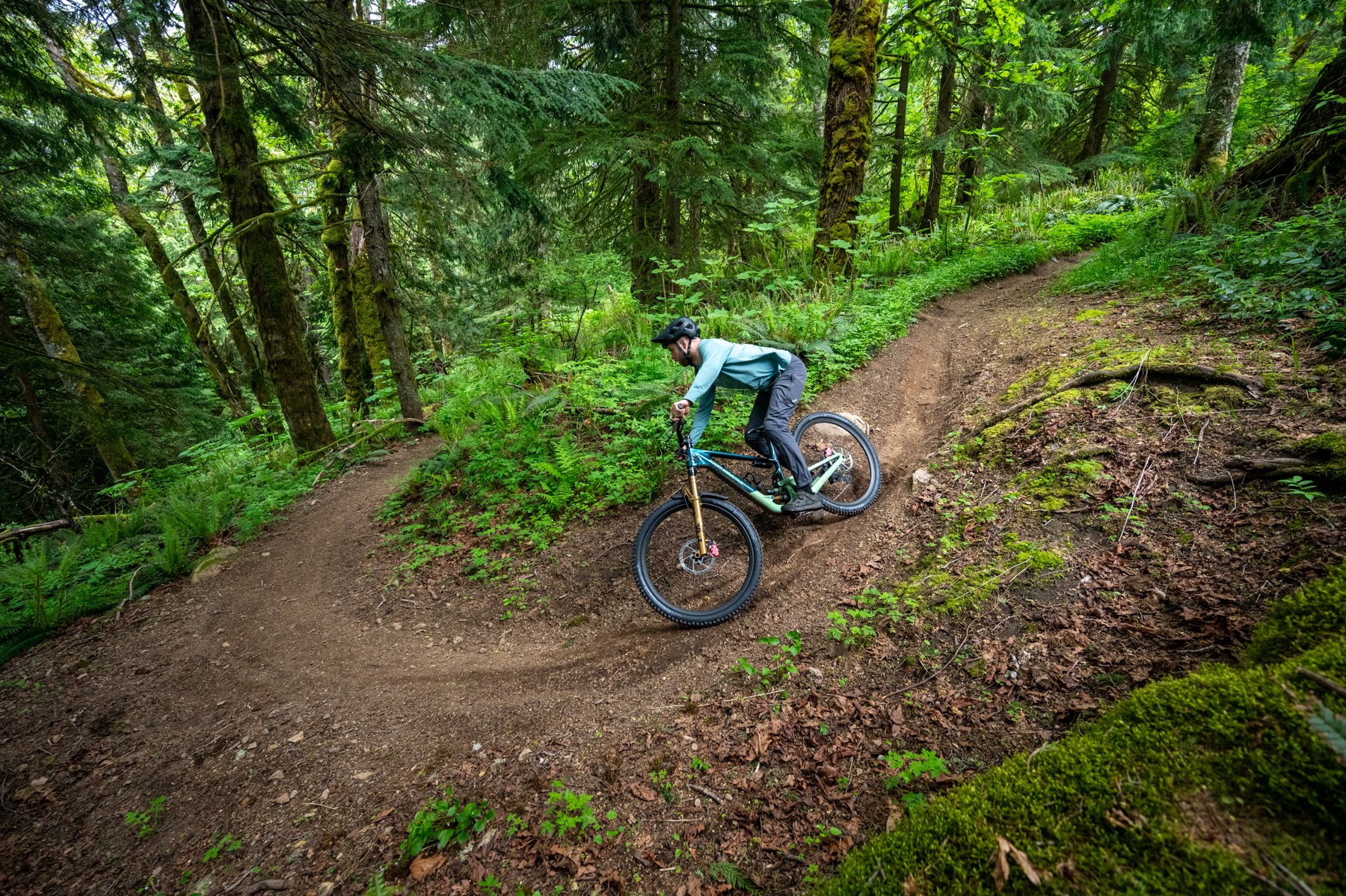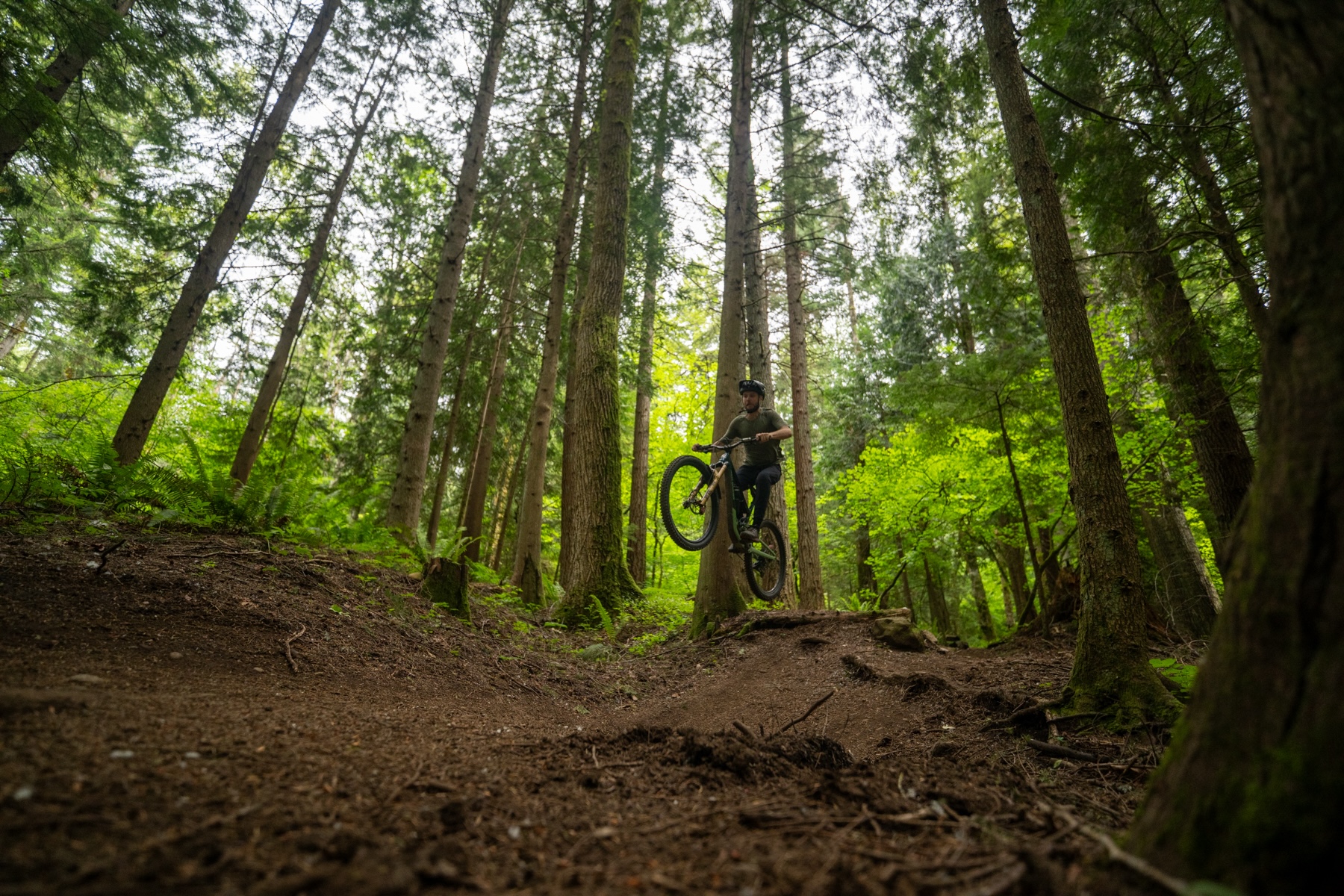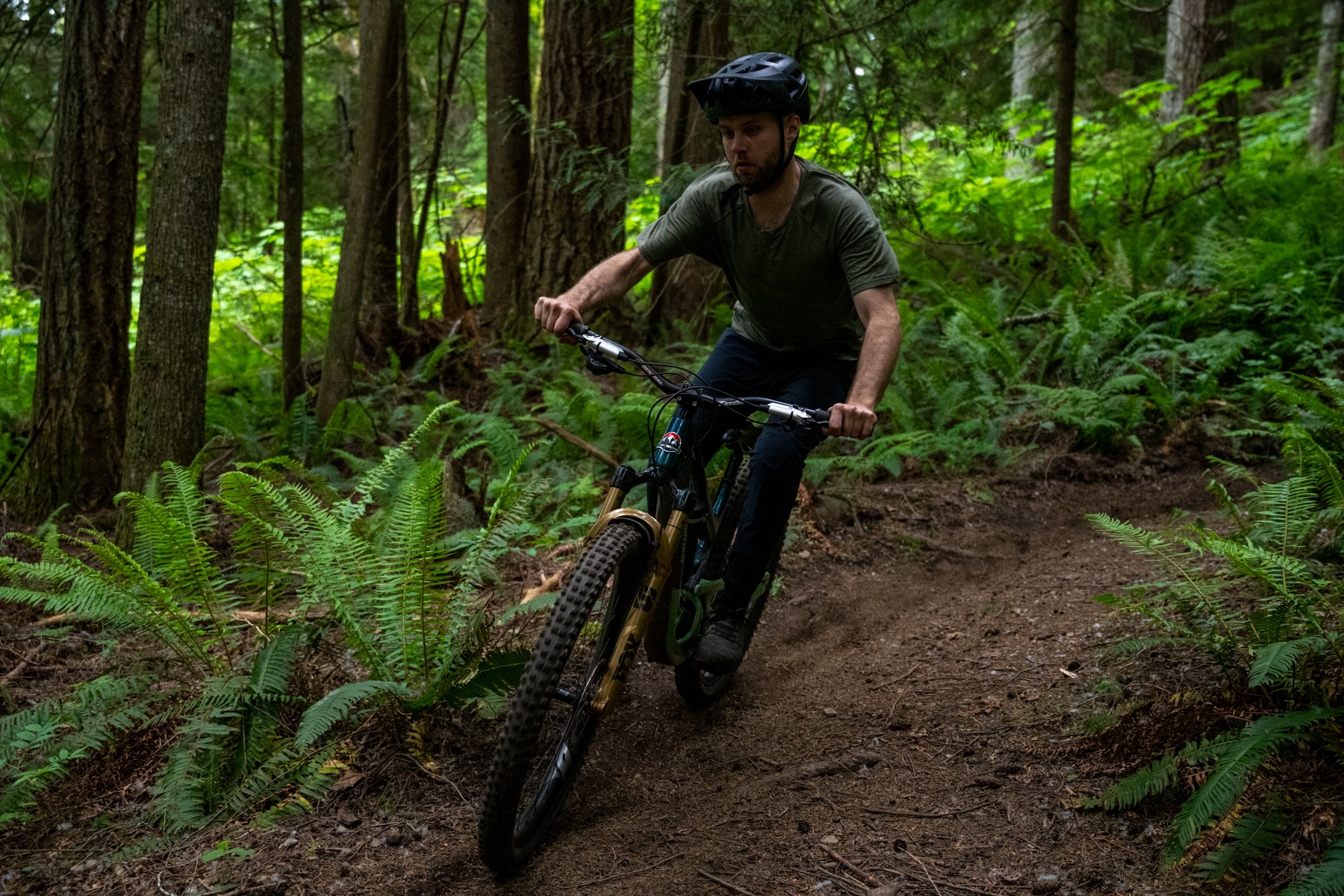2025 Fox 38 Grip X2
Travel Options: 160, 170, and 180 mm (150 mm air shaft available aftermarket)
Wheel Size Options: 27.5’’ and 29’’
Available Offset: 44 mm
Stanchion Diameter: 38 mm
Blister’s Measured Weight (29” | 170 mm travel | uncut steerer tube): 2,440 g / 5.38 lbs
MSRP:
- Fox 38 Factory: $1,249
- Fox 38 Performance Elite: $1,149
Bolted To: Rocky Mountain Altitude, Contra MC
Test Locations: Washington, British Columbia
Reviewer: 6’, 170 lbs / 183 cm, 77.1 kg
Test Duration: 5 months

Intro
Fox gave their fork damper lineup a major revamp this spring. They didn’t do a complete overhaul of most of their forks to go with it, but the new dampers alone sounded like a big update.
After spending a summer with the new Fox 38 fork, we can now verify that the performance differences between the new Grip X2 damper and the Grip2 VVC damper it replaced are profound. So, let’s dig into what Fox has come up with.

2025 Fox Forks: Updates & Options
Here, we won’t spend a lot of time on the specs of the latest 38 or Fox’s other forks — because we already went over that in our First Look at their 2025 updates.
In short, the 32 Step Cast got a new chassis, but the rest of Fox’s forks got new bushings and dampers without changing the rest of their chassis and air springs. Check out our First Look on the new dampers for a lot more on the complete range of offerings; here we’re going to focus on the 38 Grip X2 that we’ve been testing.
The 38 remains Fox’s most descending-oriented single-crown fork, with big 38 mm stanchions and travel options of 160, 170, and 180 mm (you can also buy an aftermarket 150 mm air shaft).
The model-year-2025 Fox 38 is available in ‘Factory’ (MSRP: $1,249) or ‘Performance Elite’ (MSRP: $1,149) guise. Both get you the new Grip X2 damper, but the slightly less expensive Performance Elite variant loses the Kashima-coated stanchions and currently has more limited wheel size and travel configuration options.

On-Trail Performance
Before diving into the new 38, let’s start with some background info. A lot of folks found the prior-generation Grip2 VVC damper to not generate as much compression damping (especially at higher shaft speeds) than they’d like, and I certainly count myself in that camp. Check out our Full Review of the prior-gen Fox 38 for the whole story.
I could make the Grip2 VVC Fox 36 and 38 forks work pretty well for me, but with that damper, I always felt like I was over-relying on the spring (running more pressure than would be ideal) to get the midstroke support I wanted from the forks, and to cover for the modest compression damping that was on offer, even with the damper adjusters fully closed.
(Not that it made a huge difference. The overall compression adjustment range on the Grip2 VVC damper felt quite narrow. Fox did firm up the compression tune on model-year-2024 Grip2 forks a little bit, but it was still pretty light.)
So, Fox’s stated brief for the Grip X2 damper sounded exactly like what I would have asked for — achieving much more compression damping without making the fork more harsh — and I was eager to see how they’d done.
In short, great.

At least for my preferences, the Grip X2 damper is a big improvement over the Grip2 VVC, specifically because it’s able to generate so much more high-speed compression damping, and can do so without feeling harsh or spiky on sharp impacts. That added support has, in turn, let me change my spring settings for the better, too.
My exact settings vary a little depending on the details of the bike in question, its weight balance, and its rear suspension feel. (Balancing the front and rear tends to be more important to me than getting one exact set of performance characteristics out of the fork.) That said, I generally run somewhere between 92 and 98 psi and either zero or one volume spacer in the old Grip2 version of a 170mm-travel Fox 38. That produces a slightly firmer feel off the top of the stroke than would be ideal, but is essentially what I need to do to get the midstroke support I want. Since I’m running pretty high air pressures for my weight (170 lb / 77.1 kg), I don’t need a ton of volume spacers to deal with bottom-out resistance.
[More details on fork setup: In general, bikes that favor a more centered, upright stance make midstroke support feel a little less critical than ones that want you more over the front of the bike. So, bikes that want to be ridden more upright let me compromise on spring settings a little less, and run slightly less pressure with a volume spacer to make up for the loss of bottom-out resistance.]
The 38’s air spring offers a notably wide and useful range of progression tuning via volume spacers. I think this is mostly because its extra internal tube and smaller-diameter air piston allow Fox to make it less progressive than many other long-travel single-crown forks as a baseline, with room to add spacers from there. (Check out our review of the original Fox 38 for more on that.)
That tunability let me firm up the spring more than might be ideal to get the support I wanted without making the fork wildly progressive. Still, I was pretty sure that increased compression damping / support (more than the Grip2 VVC damper could provide) would let me run less air pressure for better small-bump sensitivity and traction while still getting the midstroke support I wanted, with room to add volume spacers to get back more bottom-out resistance if needed.

With the Grip X2 damper in the new Fox 38, I’m down to ~82-86 psi and one or two volume spacers (again, depending a bit on the bike in question). When comparing those numbers, it’s important to remember that the spring design hasn’t changed.
I’m also not running the Grip X2’s compression adjusters anywhere close to fully closed — around -7 on LSC and -4 on HSC, give or take a click or two. Even so, the Grip X2 damper generates far more high-speed compression damping and, through it, much better support.
That’s most noticeable in relatively steep terrain, when you’ve already got a bunch of weight over the front of the bike due to the trail pitch, and then encounter mid-sized bumps on top of that. The 38 Grip X2 is able to manage those impacts while using less of its travel to do so than the 38 Grip2, and it consequently rides higher and feels like the bike is pitching forward much less. The new damper is more composed and quite impressive in how it’s able to generate relatively high amounts of compression damping (particularly compared to the Grip2 damper it replaces) without feeling harsh or spiking on especially sharp impacts.
The Grip X2’s adjustment range on the compression side is also much, much wider than what the Grip2 could achieve, and you don’t have to run a lot of compression damping if you don’t want to. The Grip X2 probably can’t get quite as wide open and un-damped as the Grip2, but the new version’s compression damping does feel fairly light with the adjusters opened up. I don’t think folks who like the light damping of the Grip2 VVC need to start stockpiling those dampers or anything like that (though there are very good deals on those prior-gen forks floating around right now).
I haven’t tried this (or felt I had a reason to), but the architecture of the Grip X2 damper should also make it much more straightforward to re-valve as needed, relative to Grip2. It was tough to make the Grip2 platform generate much more compression damping, even via tinkering with the shim stack.
Folks who specifically want to run more compression damping than the Grip2 damper is capable of will see the biggest benefits from an upgrade to the Grip X2 damper. That said, I also think that the Grip X2 platform will let a lot of folks run a slightly more damped, composed-feeling setup without making the fork feel harsh or lacking in compliance. And I think this applies even to those who tend to run pretty light compression settings due to whatever combination of personal preferences / weight / whatever else.
In my case, being able to run so much less air pressure than I do in the Grip2-equipped 38 has improved small-bump sensitivity substantially. Granted, I think that’s more down to the spring changes that the Grip X2 damper facilitates, rather than the damper itself.

I, unfortunately, haven’t yet ridden RockShox’s new Charger 3.1 damper in their ZEB fork, which is the 38’s biggest direct competitor. However, I do have some time with the Charger 3.1 in RockShox’s Pike and Lyrik forks. My (somewhat preliminary) take is that the Charger 3.1 damper has a considerably wider range of compression adjustment on offer than the Charger 3, especially at the lighter end of the range, and that the Charger 3.1 feels slightly smoother over smaller chatter in particular.
We’ll post some more about the Charger 3.1 once we’re able to get some more time with it in a wider range of forks (and I will be getting on a Charger-3.1-equipped ZEB shortly). So, stay tuned for more on that comparison to come.
As for the prior-gen Charger 3 ZEB vs the 38 Grip X2, the Grip X2 feels smoother and less spiky on really sharp impacts when running relatively firm high-speed compression settings. The 38 Grip X2 also stands out for how cleanly it transitions from compression to rebound with no hangup or perceived delay; the Charger 3 can feel like it stutters ever so slightly. The ZEB, on the other hand, mutes out medium-sized chatter a bit more completely. In some ways, I actually like the little bit of extra feedback that the 38 delivers in those circumstances — it doesn’t feel harsh, but does let you know what the front wheel is doing a little more than the ZEB does. That’s firmly into the realm of personal preferences, though, and if you’d prefer a fork that feels a bit more magic-carpet-smooth on that kind of stuff, the ZEB does have an edge.
The 38 chassis, unsurprisingly, feels unchanged. (Fox quietly dropped the funky oval steerer tube that the 38 debuted with a while back, but I can’t tell any difference between those two chassis variants.) The 38 chassis is still pretty stiff as single-crown forks go, but a little less so than the ZEB, especially fore-aft. The 38 still does a pretty good job of not binding up too badly under heaving braking (which is one of the best ways to get a fork to really start flexing fore-aft), but the ZEB is a bit more precise-feeling in those situations.
I don’t have as many concrete thoughts on the 2025 Fox 38’s updated bushings. The particular fork I’ve been testing came with the bushings nicely sized and it moves freely, but I’ve seen enough variation in prior-gen 38s to feel like I need a sample size of more than one to really get the full picture here. So far so good, certainly. Out of the couple dozen prior-gen 38s I’ve ridden at this point, most seemed more or less fine, but I have run into a couple that were pretty sticky. Hopefully, the new bushings are a bit more consistent, but we’ll need to test more and see there.

Who’s It For?
The new Grip X2 damper is, first and foremost, for folks who struggled to get enough high-speed compression damping and support out of the Grip2 VVC damper that it replaces.
In Fox’s 38 fork chassis, that makes for a very good, highly tunable Enduro single-crown fork with enough adjustment range to cater to a wide range of folks — not just those who specifically want to run a bunch of compression damping.
The new damper is going to be of most benefit to people who want to run more compression damping and get more support out of their fork, but it’s also got a wide enough adjustment range that I don’t think many people are going to find it overdamped with the compression adjusters opened up.
Beyond just having a much wider adjustment range than Grip2 VVC, the Grip X2 platform is an impressively adjustable, high-performing damper across the board, with the ability to run a pretty high-compression-damping setup if that’s your preference.
Bottom Line
Fox has kept the already good chassis and air spring of their 38 fork mostly unchanged (new bushings being the only real update there), but the new Grip X2 damper is a huge improvement for my preferences, and I don’t think there are going to be many people who clearly prefer the older Grip2 VVC version.
The Fox 38 chassis is still one of the stiffer, more precise-feeling single-crown forks out there, and its air spring offers an especially wide and useful range of progression adjustability via volume spacers. Improving the damper was the most obvious area for potential improvement, and Fox has done just that.

@DavidGolay Do you think this changes how effective the Vorsprung Secus will be with the 38 since there is much better hydraulic mid-stroke support from the damper? I am planning to test this theory out. I found rear end of the 24 Slash being so active off the top with a DHX2, the Grip X2 38 in the 170mm was struggling to keep up.
I haven’t tried that combo yet but I bet it would at least help with small bump sensitivity a little.
If you had to choose between this and the new era 2.1? Has the improved damper helped enough to make up the gap?
I would most definitely go with the 38 X2. I had a ERA 2.1 while the first 2/3’s of the travel were really good that last 1/3 I never could really use efficiently. I tried adding air to the negative spring with little to no success. Maybe it was my specific fork having this issue. My other problem with the ERA where the travel adjustment needed specialized tools and the service fees were pretty high.
I think out of the box the 38 x2 would check all the boxes with more support when it comes to service and parts.